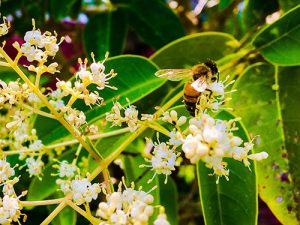Mississippi State Univ. scientist building pollen database to improve bee nutrition asks citizens to assist
A honeybee collects pollen from Japanese privet. (Photo by David Ammon)
STARKVILLE, Miss.—While flowers are known to be most attractive to bees, less is known about the nutrition flowers actually provide pollinators. A Mississippi State scientist is hoping to change that and is asking for citizen scientist volunteers to help collect data.
Priyadarshini Chakrabarti Basu, assistant professor in the Department of Biochemistry, Molecular Biology, Entomology and Plant Pathology, is building a pollen database to catalogue the nutrition profiles of over 100 bee-pollinated plants. Her work, in partnership with colleagues at Oregon State University, is funded by a $500,000 grant from the U.S. Department of Agriculture’s Agriculture and Food Research Initiative.
“The bee-friendly plants that are usually recommended for pollinator gardens are based on the bees’ relative attraction to the plant. This database will report the nutritional quality of the plants most beneficial to bees,” said Basu, who serves as co-principal investigator on the project and is a scientist in the Mississippi Agricultural and Forestry Experiment Station.
She notes that while the team has collaborators collecting pollen throughout the U.S. and Canada, the researchers also are asking citizen scientists to assist with collection.
An online training session will be held with volunteers this winter. Citizen scientists interested in volunteering to collect pollen for the project can contact Basu at pb1090@msstate.edu or by calling 662-325-6711. Ramesh Sagili, associate professor of apiculture at Oregon State, serves as principal investigator on the grant and also can be reached at ramesh.sagili@oregonstate.edu or by calling 541-737-5460. All volunteers who sign up will be provided pollen collection kits. A brief introduction to pollen collection can be found at https://oregonstate.box.com/s/4zxia14r04xaw69rvnnigm9d48qshf97.
Basu said the almond harvest in California’s Central Valley is a good example of why bee nutrition is so important. Each year, over the course of a few weeks in January and February, 30 billion bees are shipped to the Golden State to pollinate enough flowers to create 700 billion almonds.
“When the migratory beehives are transported to almond groves in California each year, the bees are still overwintering. They’re forced out of the hibernating phase into the brood-rearing phase, which can be stressful. For this reason, they need to be well fed when they arrive at the almond orchards,” she said.
Basu was inspired to start the database, in part, to help solve the challenge of providing supplemental forage as the bees travel to pollinate almonds.
“The idea is to have other nutritious forages blooming before and after the almonds bloom. This helps the bees stay healthy and strong because they have access to nutritious pollen and nectar when they arrive and before they are prepped to move to the next crop,” she said.
On the research side, Basu also sees a need for the database.
“I am focused on improving bee health through nutrition. One of my focus areas is phytosterols, a naturally occurring micronutrient found in pollen that is similar to cholesterol in humans. When I started working in this area, I realized I didn’t know the phytosterol spectrum available in different plant pollens and as I dug deeper, I saw that many of the other nutrients that bees need for a healthy diet, including amino acids, lipids, vitamins and minerals, aren’t quantified for the plants the bee pollinators frequent.”
To read the complete article go to, MSU scientist building pollen database to improve bee nutrition asks citizens to assist | Mississippi State University (msstate.edu)









